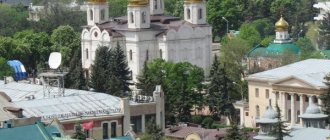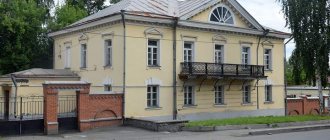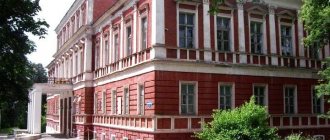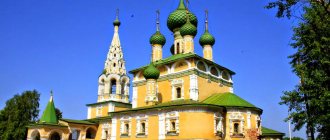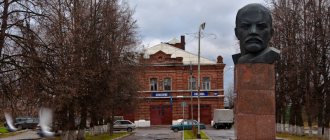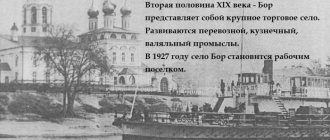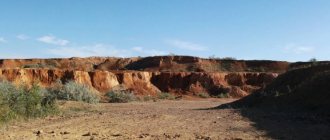Sights of the city of Obninsk.
What are the guidebooks silent about?!. Obninsk is the very first science city of the Russian Federation, this city is located in the territorial division of the Kaluga region and today we will talk about the sights of Obninsk. We have all heard the term “science city” many times, but not everyone has the concept. So, a science city is a city with a very high scientific and technical potential. The city-forming element of these cities is some kind of scientific and technical complex.
General information and history of the city
To the question: “What can you say about your city?” Every resident of Obninsk will start with the fact that Obninsk is the first science city in Russia! Yes, this is what first of all made the young city famous.
View of the city
In 1911, on the territory of the future Obninsk, teacher Shchatsky founded a boarding school named after. Shchatsky S.T. “Vigorous Life”, on the site of which a secret facility of the USSR Ministry of Internal Affairs system was created called “Laboratory “B”” (the future Institute of Physics and Energy). The laboratory's activities were aimed at research in the field of nuclear physics; German scientists and the best Soviet specialists were invited for this purpose. As a result, the Obninsk Nuclear Power Plant was built - the world's first nuclear power plant, which was put into operation in June 1954.
This event brought world fame to the future city, which received official city status in 1956.
Obninsk NPP
In addition, ten more research institutes were built in Obninsk. Currently, Obninsk is a major scientific center and has the status of the first science city in Russia, which was officially awarded to the city in May 2000.
At the moment, Obninsk, with a territory of about 43 km2, is located in the north of the Kaluga region, 100 km from the capital in a southwestern direction along the M3 highway.
Museum
For those who are more interested in the modern development of Obninsk, it is better to visit the Museum of the History of Obninsk with a large exhibition hall and an art salon. Its composition contains photographs and documents about the consistent development of the city, the construction of the country's first nuclear power plant and the highest meteorological tower in Europe, its other attractions and people who left their mark not only on Obninsk land, but those whom all of Russia knows. The guides will be happy to guide city guests through the museum’s exhibition and answer questions that interest tourists. In addition to the permanent composition, the museum periodically hosts thematic exhibitions, also related to the history of the city.
Climate and ecology of Obninsk, or “City in the Forest”
Obninsk is located in a temperate continental climate zone in a mixed forest, with cold snowy winters and warm humid summers. Autumn is moderately cool, the temperature in October is not lower than 5 ◦C.
Winter Obninsk
Spring is cold. She especially surprised residents in 2012. When all the snow on the streets had almost melted, heavy snowfall began on the night of April 5, which subsided only in the morning. Obninsk was literally covered with snow. The streets of Obninsk became impassable. Car owners had to dig their cars out of huge snowdrifts, and those who went out first had to work as bulldozers.
Obninsk from a bird's eye view
The air in the city is humid, about 76-78%, clean, despite the fact that on the outskirts, in the area of the old part of the city, there are sewage treatment plants, the impact of which is very rarely felt by residents of the area. The winds are also small, mainly the flow occurs on the two main streets of the city - Lenin Avenue and st. Kurchatov, which is due to their elongation. Naturally, the science city is not sparse in vegetation.
The Protva River (a tributary of the Oka) flows along the outskirts of the city, the cleanliness of which is not deplorable, but leaves much to be desired, but despite this, every summer the townspeople rush to swim and sunbathe at the local beach. Several ponds located in the city have the same condition.
View of the city from Belkinsky Park
Population of Obninsk
According to the latest estimates for 2014, the number of residents of Obninsk is 107.3 thousand people, which corresponds to 1/10 of the population of the Kaluga region.
It is the second largest city in the Kaluga region, after Kaluga. The pride of Obninsk are its honorary citizens. Among them are veterans of the Great Patriotic War (just under 400 people), public figures, scientists, sports and cultural workers. All of them made a significant contribution to the development of the city of Obninsk.
Veterans of the Great Patriotic War
The issue of local demographics, as throughout the country, remains unresolved. Over the past few years, the city has recorded a natural population decline (as of 2010, 1186 births and 1387 deaths, therefore, the natural population increase is 201; however, due to the fact that there are 376 more arrivals than departures, the total population increase is 175 people). .
Note that the number of Obninsk residents is still growing due to the fact that more than 1000 new citizens arrive in the city every year, and it is always higher than the rate of those leaving.
62% of the population are of working age. The average age of city residents is 38 years. There are 10% more women than men in percentage terms.
The share of students in daytime general education institutions accounts for about 15 thousand people in the population, which is 32% less than in 2000, and is due to a decrease in the birth rate during the years of perestroika.
The majority of the population are highly educated citizens. It’s not for nothing that Obninsk is the first science city in Russia. And all because the city has high scientific and technical potential (12 industry research institutes and a university).
Institute NRNU MEPhI
Most citizens take an active position in resolving city issues. Cleaning campaigns, beautification of the city, and helping those in need are often held, in which many participate to the delight.
Obninsk athletes are also not asleep. The city has a lot of sports clubs, several Olympic reserve schools, and the Olympus sports complex recently opened. Here such athletes as Nikolai Skvortsov (European champion, medalist of the world swimming championships), Mikhail Aloyan (world boxing champion), Alexey Egorov (European boxing champion) and many others grew up and continue their careers.
Districts and real estate of Obninsk
Map of the territorial division of the city of Obninsk
A small territory of the city is divided into districts, which are in turn divided into microdistricts, the number of which is fifty-two. It would be correct to begin describing the districts with the “father district” of the city, which stands unshakably, having seen many Obninsk residents in its, albeit short, lifetime. Residents of Obninsk call it Old Town.
It was from here that the construction of the city began. It does not leave anyone indifferent with its residential buildings in the style of the 18th-9th centuries, with their characteristic yellowish tints.
Typical residential building in the Old Town area
The area is quiet, there is no unnecessary fuss. In the old town there is a Park of Culture, where you can not only relax by the fountain, in a cozy summer cafe or while walking in the park, but also take your children with you, who will be interested in playing in the equipped children's playground, part of which can be seen in the photo below .
In general, Park Kultury has noticeably changed over the last 5 years. Apparently the city administration finally turned its attention to the fact that the child population needs this. And this can be said not only about the park; many courtyards miraculously began to surprise the townspeople with their equipped sports fields and playgrounds.
Children's playground in the Park of Culture
Real estate in this area is relatively inexpensive. Relatively, because the city is located not far from Moscow, so prices still make themselves felt. This applies to all areas of the city.
When entering the science city from Kaluga, you can see the small village of Obninskoye. Which consists mainly of small, private houses. The village is connected to the city by the railway station, which has undergone a significant transformation over the past few years.
Another village located on the territory of the city is Mirny. It is largely a residential area, as it is located on the outskirts of Obninsk. Housing there is inexpensive compared to other areas of the city, however, there are several dozen houses that are to be demolished. In their place, new 7- or 9-story buildings will be built, which will be the property of a Moscow company that has taken upon itself the responsibility for their construction. So, for example, in 51 microdistricts of the city, many houses were erected by the Moscow regional government. Therefore, living in this area costs citizens a little more.
Old house before demolition
Also in the area there is already a zone of modern multi-storey buildings, which is developing according to the planned scenario. In addition, 51 microdistricts cover Karl Marx Avenue, this is a busier part of the city.
The Triumph Plaza shopping and entertainment center built here does not go unnoticed. In the future it is planned that this area will be the center of the city. Probably due to the high concentration of trading activity in the area.
Shopping center Triumph Plaza
The current center of the city is the 39th district or Aksenov Square. You've probably already noticed that many city streets are named after famous scientific and cultural figures. Here is another, perhaps imaginary, but confirmation that Obninsk is a Science City. As in many cities of great Russia, people gather most of all near markets, shops, and entertainment centers, so it happened in this city.
In addition to the open market on the central square, there is a trading house under the same name Aksenovo, as well as several other shopping complexes. Near the square there is the central city library, a music school and an Orthodox church. This is the busiest area of the city.
All large-scale events, such as City Day, New Year's Eve with fireworks, and meetings with celebrities take place right here, on the central square.
Another concert on Aksenovskaya Square
27 microdistrict separated from the center by the Guryanovsky forest and another Obninsk attraction - a weather tower, but more on that later. This is also a busy part of the city, most of the local townspeople work at the , which once provided the skin for the Russian reusable shuttle for space flight, which far surpassed the American shuttle in quality. Typical “five- and nine-story buildings” filled almost the entire area. The courtyards are well equipped with playgrounds and playgrounds, schools, kindergartens, shops. The average residential area of Russian cities.
27 microdistrict
Well, a little about “Sunny Valley”. This area is still being built up, as can be seen in the picture. Now on this territory there are two villages - Olimpiyskaya and Belkino. However, they cannot be called villages; a more accurate name that would characterize them is modern cottage villages. One such house, shown in the photograph, costs about 3-4 million rubles.
Olimpic village
If you want to live near the capital, in a cozy, quiet, modern city, Obninsk is one of the best options.
How to get there
You can easily get to Obninsk from almost any big Russian city, because it is located only 1 hour drive from the Moscow ring highway.
By plane
At a distance of about 100 km from Obninsk there are 3 Moscow airports, from which you can get to your destination in 1.5-2 hours. The plane is considered the most optimal way to get to the city from remote regions.
From any airport in the capital, people first travel by metro (Kievskaya station) to the station, and from there to the populated area they need to go by train, the average cost of which is 240-280 rubles.
By train
Obninsk has a railway station, the station has the same name. This route connects Moscow and Bryansk. When purchasing a ticket to a desired stop, you should keep it until the end of the trip.
So, you can get to Bryansk by train in 4.5 hours. The cost of such a trip will cost at least 1000 rubles. The train will take passengers from Obninsk to the regional center in 1 hour. The ticket price will be about 380 rubles.
By bus
From the Russian capital, buses heading to Obninsk leave from the bus station located near the station. m. "Teply Stan". When purchasing a travel pass, you must present your passport, because personalized receipts are issued. Traffic flows along the Warsaw Highway. The trip takes about 1.5 hours. Ticket prices start from 215 rubles.
From the Obninsk station there are regular flights to the following settlements:
| Name of the locality | price, rub. | Travel time, min. |
| Zhukov | 25 | 20 |
| Serpukhov | 210 | 90 |
| Bryansk | 360 | 4-5 hours |
| Roslavl | 870 | 18:00 |
| Korsakovo | 180 | 70 |
| Novozybkov | 1420 | 14 hours 50 minutes |
| Dyatkovo | 685 | 4 hours 20 minutes |
| Kaluga | 100 | 90 |
By car
Obninsk on the map of Russia is located in the intersection zone of federal highways. There are several variations to get to the science city by car. In the urban area, 2 large highways intersect (M3 and A101). Both lead from Moscow.
One of them heads through Yaroslavl to Brest, and the other leads to Kyiv. Also nearby (approximately 5 km) is the A108 or Big Ring road.
City infrastructure
Throughout Russia, the issue of fools and roads, and fools on the roads, still remains unresolved. And although not only roadways, but also pedestrian sidewalks, and even in courtyards, are repaired here very often and in large quantities, there is still a problem with the road surface, probably after the famous Russian winter, after which these holes and potholes appear on the roads .
This cannot be said about all the streets of the city. Naturally, the central streets of the city have a neat appearance in this regard, although sometimes you can stumble upon small holes there. What can we say about secondary alleys and courtyards? Here, of course, things are worse.
The city's transport infrastructure is in the best condition. In addition to shuttle buses, there are many Gazelle minibuses that don’t make you wait long at stops. Also pleasing is the availability and low cost of passenger taxis that will take you to any part of the city.
The number of car owners is also not small; in every yard you will see cars standing by the sidewalk or on the sidewalk, waiting for their owners. The problem is that there are few equipped parking spaces in the courtyards.
It is no longer profitable for lazy car owners to go to a paid parking lot, leave the car there and return home on foot. However, despite such a large number of vehicles and in some places the road condition is not the best, traffic in the city is relatively free. Congestion, and moreover, traffic jams, occurs very rarely, thanks to the breadth of the central streets and parking spaces equipped on them, and of course, well-organized traffic regulation.
The city's housing and communal services are also different in different areas. In areas 27, 51 and central, the situation is slightly better than in the area of the old city and two villages. For the latter, the problems with public utilities are that many houses that are subject to demolition in the near future, according to the city administration’s plan, which is already being implemented, although not quickly, need major repairs, and therefore they are not paid much attention to , which the residents, of course, do not like, because it may take a long time to wait until they are moved to the new houses that they are promised.
House to be demolished
Note also that even they never have problems with power outages or water supply. Emergency shutdowns happen very rarely here, I don’t remember the last time it happened. The rent, for example, in such houses is from 3 to 6 thousand rubles. In busier parts of the city, prices are naturally higher.
The city administration needs to work much more effectively to improve the cleanliness of the streets. You can often find filled garbage cans on city streets, and even scraps lie around the trash can. For this reason, local organizations often try to organize “subbotniks” and restore order in their hometown on their own. Where would we be without them? Fortunately, people respond to the request for help.
Cleanup day in Obninsk
Another problem of the city is kindergartens. To register their child there, young mothers have to wait in line even before the baby is born, which creates quite a few problems for the young family. However, when your student has grown to school age, you will not have any problems placing him in a secondary school or a specialized lyceum, where he can gain great knowledge. Once again, it is not for nothing that our city is called a science city.
Lyceum "Derzhava"
Main attractions
Obninsk appeared on the map of Russia relatively recently, however, it has about 100 attractions. Among them, both natural and man-made interesting places stand out.
Weather tower
One of the highest meteorological towers in Europe was built in Obninsk, its length is 310 m. The meteorological tower called VMM-310 “Typhoon” was put into use in 1959. The structure is based on a spherical device; an elevator functions inside the mast for the movement of experts.
The design is made to measure many different atmospheric parameters, followed by their computer systematization. The information obtained using the weather tower is used to solve applied and scientific problems. The tower stands at the intersection of the street. Guryanov and Komarov.
Estate "Bugry"
The Bugry estate began its existence at the end of the 19th century. The estate belonged to A. Obninskaya, who inherited it from her parents. To this day, what has survived from the complex is a single-tier log dwelling with a mezzanine. Behind him stretched a large garden, and in front of the front of the house there was a picturesque park with exotic vegetation.
In 1932, the estate was sold to the painter P. Konchalovsky, and in it he created almost all of his Central Russian panoramas. Estate address: st. Dacha (after passing the church, you need to turn onto a country road that goes uphill). You can get here by public transport to the stop. "Konchalov Mountains".
Morozovskaya dacha
The Morozov dacha was built in the New England style at the turn of the 19th-20th centuries. designed by architect V. Lopatin. The owner of the estate was V. Obninsky, but since 1909 the estate was owned by M. Morozova. The new owner gave permission to establish a colony school on these lands for Moscow children from working families who lived in poor conditions. During the Second World War, the Red Army headquarters was based here.
After the war, a major renovation was carried out at the dacha, and then a hotel was opened in it. Now the mansion is under state protection, but, nevertheless, its condition is falling into disrepair. The estate rises on the top of a hill in a pine forest at the junction of the river. Repinka and Protva and has the address st. Pirogova, 1. You can walk here in a few minutes from the IPPE.
Museum of Obninsk History
The Obninsk Historical Museum opened its doors to visitors in May 1965. 27 years later, the institution moved to a specially constructed new premises, which resulted in an increase in staff and the creation of additional exhibitions. An exhibition and art salon was also founded. The museum collection numbers about 50 thousand items.
It tells about the historical events of the region and the emergence of the city. The Obninsk Museum includes two areas - local history and art. The institution is located at Lenin Ave., 128 and is open on Thursdays from 13.00 to 21.00, closed on Mondays, and on all other days the exhibition is open from 10.00 to 18.00.
The price of an entrance ticket for adults is 40-60 rubles, and preferential categories will have to pay 20-30 rubles. Entry cost for foreigners is 80-120 rubles. It is better to go here from the railway station by minibus No. 9,2,15 and 12 to the stop. "House of Scientists"
Guryanovsky forest
The Guryanovsky Forest is a large-scale forest zone in the central part of the city. After the collapse of the USSR, it fell into disrepair. At the present time, most of the forest space has become its own territory and is registered in the cadastral register. Here the space is being improved, pedestrian paths are laid and playgrounds are installed.
Belkinsky Park
The Belkinskaya park area extends on the northwestern outskirts of Obninsk in the village of the same name. The green space is clean and can be visited 24 hours a day.
There are a large number of picturesque places here - a gazebo, ponds, centuries-old trees, decorative bridges, the remains of an estate and the active church of St. Boris and Gleb.
The highlight of the park is the cascade of ponds. It is better to go here by public transport to the stop. "Belkino".
Suspension bridge over the river. Repinka
The suspension bridge began its existence in 1961 and it was laid across the ravine in which the river flows. Repinka. Initially, the cables replaced the cables used on the city's television mast. At the beginning of the XXI century. the pontoon fell into disrepair and for 10 years residents crossed the ravine below along the path.
In 2015, a new bridge was built at the same place, which is supported on metal piles. The structure connects the Old part of the city with the village. Peaceful. The suspended track is located near school No. 1 on the street. Pirogova, 17.
Eternal flame
The eternal flame was built on the mass grave moved from Lenin Avenue in 1972. The memorial complex was built according to the design of L. Alexandrov at the intersection of st. Zhukov and Mira. The monument is dedicated to the heroes of the Second World War who were buried on Obninsk land. About 300 names of warriors are engraved on granite plates, and hero cities are also indicated. Here is the final station of bus routes No. 1, 2 and 103.
Sculpture “Scientist Cat”
The figure of the “Scientist Cat” appeared in the city in 2013 due to the fact that a hundred-year-old oak tree remained nearby, and everyone knows the lines from Pushkin’s poem “Ruslan and Lyudmila.” The sculpture was installed near the facade of the House of Scientists at Lenin Ave., 129. You should go to this place by bus to the stop. "House of Communications"
Church of Boris and Gleb
Near the dilapidated Belkino estate stands the Church of Boris and Gleb, erected in 1776. The sanctuary was part of a manor complex built according to the design of V. Blank. The architectural traditions of Catherine’s times are noticeable in the outlines of the building. It also successfully combines classicism and baroque motifs. The inside of the church is painted using the grisaille technique.
During Soviet times, the temple was closed and a warehouse was built in it. After a long lull, the first service was held here in July 1988. Now the temple complex hosts a year-round cycle of services, and also operates an Orthodox school and library. Sanctuary opening hours: Wed and Fri from 18.00 to 19.00, Sat and Sun from 8.30 to 19.00.
Monument to Academician Kurchatov
The bronze monument to I. Kurchatov depicts the famous physicist, head of the Nuclear Power Plant project. The monument was made according to the design of O. Komov and looks like a slightly enlarged figure of an academician who sits in a chair on a low pedestal.
Nearby lies a birch grove, which has become an integral element of the composition. The sculpture was installed on the street of the same name, 21, in the park near the Central Park.
Monument to the Pioneers of Nuclear Energy
The first monument on the planet dedicated to the pioneers of nuclear energy was erected in the Russian science city of Obninsk in 2016. The monument is a silver sphere, in front of which stands a man with his hand outstretched high.
All nuclear settlements of the state are marked on the back of the ball. The composition is located on Triangular Square. The nearest public transport stations are Magazin Malysh and St. Department store".
MiG-21 aircraft
The monument was erected in 2016, and its main exhibit, a real MiG-21, was made more than half a century ago, and it was opened in honor of the 60th anniversary of the science city. The plane actually flew for quite a long period. This vehicle is a supersonic light fighter.
The combat vehicle is parked on Gagarin Ave., at the main entrance of the Tekhnologiya plant. The nearest bus stop is called “Gas Station”, from it you need to walk 700 m.
Big fountain
A large fountain delights residents and guests of the city at the intersection of the street. Zhukov and Pobeda. The reservoir was in a neglected state for a long time, and only in 2014 restoration work began here.
After reconstruction, water jets rise above the bowl to the accompaniment of music.
The area adjacent to the building was landscaped - tiles were laid, benches were installed, bicycle parking was installed and lighting was installed. Bushes and trees are planted around the fountain.
Eiffel Tower
Although Obninsk is located on the map of Russia and not in France, it has the Eiffel Tower. In reality, the structure is a scaled-down model of the iconic landmark.
Obninsk has its own mini Eiffel Tower.
The figurative tower was installed in 2014, and is used mainly as a subject for photographs. At night, the tower is illuminated. The structure stands on the street. Kurchatova, 41, near the Akond office complex.
Church of the Nativity
The Church of the Nativity of Christ stands on Aksenovskaya Square and has the address: st. Engelsa, 12. This is a fairly young temple, built at the beginning of the 21st century. The sanctuary has beautiful decorations and gilded domes. There is a Sunday school on the temple grounds. The holy place can be visited daily from 9.00 to 19.00, and on Sunday the church is open from 6.30 to 19.00.
Old water tower
At the intersection of the street. Blokhintsev, etc. Lenin, the water tower erected by captured Germans in the middle of the 20th century has been preserved. The building was built in the Stalinist Empire style.
The design was intended to supply water to the settlement of object “B”, which was transformed into a city, and the relevance of the design was lost. Now the tower is part of private property, but it is not used in any way. The object acts as an element of the architectural ensemble and as a technical monument of the last century.
City Palace of Culture
Obninsk Palace of Culture is a cultural and educational municipal institution whose main task is the spiritual development of the population. Large-scale events are held here at both the city and all-Russian levels.
One of the main purposes of the complex is to develop amateur creativity in children and young people. The palace is located at: Lenin Ave., 126 and is open daily from 9.00 to 18.00. To get there you need to take a minibus to the stop. "House of Communications"
House of Scientists
In Obninsk in 1979, the House of Political Education was founded, which was eventually transformed into the House of Scientists. The institution hosts various educational, social and sporting events. There is a concert hall with a capacity of 615 seats and a lecture room with a capacity of 220 people. Large-scale conferences and forums are held in the main hall of the building.
The building was built according to the design of St. Petersburg architects, and Obninsk craftsmen designed the interior. The House of Scientists is located at Lenin Ave., 129. From Mon to Fri, the organization’s doors are open to visitors from 10.00 to 19.00, and on Sat and Sun its operating hours are from 10.00 to 18.00.
House of Culture of the Physics and Energy Institute
The IPPE House of Culture was put into operation in 1954. A number of circles functioned here, which later grew into large groups: a folk theater, 2 orchestras and a dance group. The cultural center was included in the list of historical and cultural city sites in 1991.
The Palace of Culture is part of the compositional ensemble of the Old Town and is located at 15 Lenin Ave. The organization is open daily from 8.00 to 22.00.
Cinema "Mir"
The cinema is located on the street. Shatsky, 20 and has been a favorite vacation spot for city residents for many years. Not so long ago, it underwent a major renovation, and now there are Large and Small cinema halls with a total number of seats designed for 390 people. Ultra-modern equipment is used to display films in three-dimensional image formats.
The repertoire includes both domestic and foreign films. The cinema building hosts various shows and events. The cinema is open to visitors every day from 10.00 to 23.00. The price of entrance tickets varies between 170-300 rubles.
4-hall cinema CINEMA De Lux
The modern multiplex CINEMA De Lux has 4 halls with 480 seats, and is also equipped with the latest rear projector and sound system. The complex also includes a minibar and a games area. Cinema location: Marx Ave., 45 (on the 3rd floor of the Triumph Plaza shopping and entertainment complex).
On weekdays, the cinema holds screenings from 12:00 to 00:00, and on Saturdays and Sundays they show 1 hour earlier. Tickets are in the price range of 150-350 rubles. There are many bus routes near the complex.
Cinema in the Leisure Center
The Obninsk “Leisure Center” is a cozy area that is popular with the local population. Here they show new releases from around the world and animated films for children. The cinema room has comfortable chairs.
The building was built on the street. Engelsa, 2-a and you can get to it by minibus to the station named after the street. At the cinema, screenings begin in the morning, and the last show starts at 20.15. The cost of entrance tickets varies in the price range from 150 to 300 rubles.
Chamber hall of the central library system
The centralized network of Obninsk libraries consists of 10 public library institutions. This system has at its disposal a chamber hall with 50 seats, located on the street. Engelsa, 14. Various concerts are regularly held there. It is better to get to the place by bus to the stop. "Music school" or "st. Engels".
Enterprises and work in Obninsk
Although Obninsk is called a science city, considerable efforts of the administration were spent on the industrial development of the city. Agreements were concluded with foreign companies. Large (even all-Russian and world-wide) industrial enterprises were built.
The main economic areas are the food industry, which includes the production of sausages, dairy and alcoholic beverages; construction industry – metal and reinforced concrete structures, plywood products, etc.; also instrument-making, this primarily includes the production of computer equipment, military equipment, equipment for nuclear power plants, etc.; chemical and pharmacological industries for the production of auto chemicals, polymer pipes, pharmaceutical products and much more.
Samsung Factory
In 2006, a technology park was built on the outskirts of the city, which houses several huge industrial enterprises, including even nanotechnology. In addition, the city has a developed trade industry, a large number of shopping and entertainment centers and complexes, where you can find everything your heart desires and have a great rest. And we're not talking about the numerous trading houses and supermarkets.
There is a job for everyone in the city, they don’t seem to complain about it here, the salaries are quite good, of course, this is an elastic concept, it varies in different areas. In the employment center there are mostly low-paid jobs, however, at bus stops you can often find advertisements with salaries starting from 25 thousand rubles. Basically it is. Working conditions are, of course, different everywhere; it is impossible to say generally about all of them, citing one enterprise as an example. However, the good news is that there are a considerable number of enterprises with excellent working conditions.
Some organizations even encourage and encourage part-time work for students. An example is Home Credit & Finance bank. But this is far from the limit. According to statistics, the average salary of city residents is 21,000 rubles. And the official unemployment rate is 0.52%. Not bad. But don’t delude yourself, these are only official statistics.
What to bring
Obninsk on the map of Russia is located in the center of the European part of the state. That’s why the city and its surroundings are famous for the craftsmen and craftsmen who create original Russian crafts.
There is a TVC here called “Russian Souvenir”, which has established itself as the only place where almost the entire souvenir assortment of Russian traditional crafts is offered. Center address: st. Aksenova 9 B, on the ground floor of the Zvezdny shopping center.
Tarusa embroidery
The Tarusa production association for the production of embroidery was transformed from an artel of embroiderers created in 1924. Initially, it employed 30 employees who produced embroidered tablecloths, runners and various items of clothing. Pattern ideas, including Kaluga folk motifs, were supplied to factory workers by Tarusa peasant women.
Until 1992, the company produced souvenirs and products for exhibitions. Now you can buy embroidered items at the factory of the same name, located in Tarusa on the street. Shmidta, 14 a, in the store. It is open to visitors daily from 9.00 to 18.00. On Fri – Sun all retail premises close at 19.00. The cost of souvenirs does not exceed 2500 rubles.
Khludnevskaya pear
Khludnevsky fishing arose at the beginning of the 19th century. in the village of the same name, Kaluga region. Mostly, the craftsmen worked in a family contract, where men only produced dishes. And women made toys and painted them. Not the entire product was painted, but only its individual parts. In the middle of the 20th century. this craft constantly faded away, and then reasserted itself 20 years later.
Currently, clay toys are made by hereditary craftsmen in the village of Khludnevo, village. Dumnichi, as well as descendants of Khludnevsky artisans in the regional center. You can buy painted crafts in souvenir shops. Their price range is from 250 rubles. up to 1000 rub.
Gingerbread of Obninsk
You can bring a specially issued souvenir gingerbread as a souvenir of the city. It is baked according to an old Kaluga recipe. The weight of such a dough product is 700 g, and you can buy it for 350 rubles. Gingerbread is sold in the shopping center “Planet of the Seagulls” on the street. Aksenova, 17. The store is open daily from 10.00 to 20.00, on Sunday it closes at 19.00.
A distinctive feature of Obninsk are Soviet buildings, partially out of use. There are many similar cities on the map of Russia, but this settlement has every opportunity to interest travelers with any requirements.
Article design: Oleg Lozinsky
Crime
If you read the crime chronicle of Obninsk in a newspaper or on the Internet, you will see that most crimes are thefts. They make up more than half, or rather about 70% of all crimes. This is the theft of money on the street, mobile phones, bags, there are also counterfeit bills, most often in denominations of 1000 rubles.
Fights and drunkenness, theft of cars or their contents are a little less common, although they are stolen no more often than bicycles; you can also see notes about burglaries, which have become much less frequent lately. Articles about crimes against human life and health are published even less frequently.
There were no particularly pronounced oddities in the history of Obninsk, perhaps only in 2006, the rape and murder of a young girl of about 25, by a security guard at the store where she worked, in the area of the old city, after she was returning from a night shift. But this is an isolated case. Moreover, if you believe the media, more than half of all crimes were solved, including about 40% without delay. We must pay tribute to the employees of the Department of Internal Affairs, who do not sleep at their posts. And sometimes they carry out operational preventive operations, during which weekly raids are carried out to protect public order and ensure security, and operations to work with teenagers. All these events are going well.
In general terms, we can say that city residents do not have to fear for their lives and property, but still be on guard. Life is given by God and should be appreciated!
